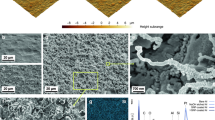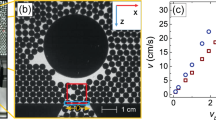Abstract
Loss of braking power and rubber skidding on a wet road is still an open physics problem, as neither the hydrodynamic effects nor the loss of surface adhesion that are sometimes blamed really manage to explain the 20–30% observed loss of low-speed tyre–road friction. Here we report a novel mechanism based on sealing of water-filled substrate pools by the rubber. The sealed-in water effectively smoothens the substrate, thus reducing the viscoelastic dissipation in bulk rubber induced by surface asperities—well established as a major friction contribution. Starting with the measured spectrum of asperities one can calculate the water-smoothened spectrum and from that the predicted friction reduction, which is of the correct magnitude. The theory is directly supported by fresh tyre–asphalt friction data.
This is a preview of subscription content, access via your institution
Access options
Subscribe to this journal
Receive 12 print issues and online access
$259.00 per year
only $21.58 per issue
Buy this article
- Purchase on Springer Link
- Instant access to full article PDF
Prices may be subject to local taxes which are calculated during checkout




Similar content being viewed by others
References
van der Oetelaar, R. J. A. & Flipse, C. F. J. Atomic-scale friction on diamond (111) studied by ultra-high vacuum atomic force microscopy. Surf. Sci. 384, L828–L385 (1997).
Moore, D. F. The Friction and Lubrication of Elastomers (Oxford, Pergamon, 1972).
Persson, B. N. J. On the theory of rubber friction. Surf. Sci. 401, 445–454 (1998).
Persson, B. N. J. Adhesion between an elastic body and a randomly rough hard surface. Eur. Phys. J. E 8, 385–401 (2002).
Persson, B. N. J., Albohr, O., Creton, C. & Peveri, V. Contact area between a viscoelastic solid and a hard, randomly rough, substrate. J. Chem. Phys. 120, 8779–8793 (2004).
Grosch, K. A. in The Physics of Tire Traction: Theory and Experiment (eds Hays, D. F. & Browne, A. L.) 143 (Plenum, New York–London, 1974).
Persson, B. N. J. Theory of rubber friction and contact mechanics. J. Chem. Phys. 115, 3840–3861 (2001).
Klüppel M. & Heinrich, G. Rubber friction on self-affine road tracks. Rubber Chem. Technol. 73, 578 (2000).
Heinrich, G. in Elastomerreibung und Kontactmechanik (Deutsches Institute für Kautschuktechnologie, Hannover, Germany, 2003).
Meyer, W. E. & Walter, J. D. Frictional Interaction of Tire and Pavement 85 (American Society for Testing and Materials, Special Technical Publication 793, 1983).
Roth, J. Fortschritt-Berichte VDI Reihe Vol. 12, No. 195 (VDI, Düsseldorf (1993).
Brochard-Wyart F. & de Gennes, P. G. Dewetting of a water film between a solid and a rubber. J. Phys. Condens. Matter 6, A9–A12 (1994).
Martin, P. & Brochard-Wyart, F. Dewetting at Soft Interfaces. Phys. Rev. Lett. 80, 3296–3299 (1998).
Persson, B. N. J., Volokitin, A. I. & Tosatti, E. Role of the external pressure on the dewetting of soft interfaces. Eur. Phys. J. E 11, 409–413 (2003).
Acknowledgements
Work in SISSA was sponsored by the Italian Ministry of University and Research through MIUR COFIN 2003, and MIUR FIRB RBAUO1LX5H as well as through Istituto Nazionale Fisica della Materia, grant INFM FIRB RBAU017S8R. We very recently learnt that related unpublished ideas have also been expressed by G. Heinrich, S. Kelbch, M. Klueppel and E. J. Schramm in Dresden.
Author information
Authors and Affiliations
Corresponding author
Ethics declarations
Competing interests
The authors declare no competing financial interests.
Rights and permissions
About this article
Cite this article
Persson, B., Tartaglino, U., Albohr, O. et al. Sealing is at the origin of rubber slipping on wet roads. Nature Mater 3, 882–885 (2004). https://doi.org/10.1038/nmat1255
Received:
Accepted:
Published:
Issue Date:
DOI: https://doi.org/10.1038/nmat1255
This article is cited by
-
Physical Model of Tire-Road Contact Under Wet Conditions
Tribology Letters (2020)
-
Time-Dependent Fluid Squeeze-Out Between Soft Elastic Solids with Randomly Rough Surfaces
Tribology Letters (2012)
-
Hindered rolling and friction anisotropy in supported carbon nanotubes
Nature Materials (2009)



